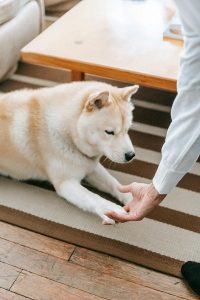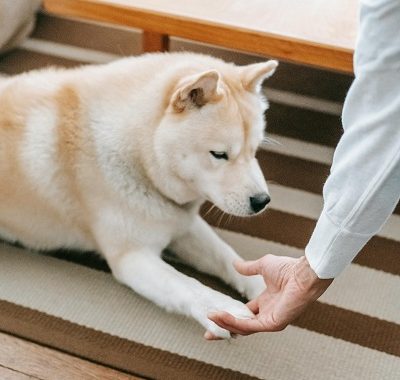
Our four-legged companions bring immense joy and happiness to our lives, and just like us, they too may face physical challenges as they age. Canine physical therapy at home is gaining popularity as a proactive approach to enhance the overall well-being of our furry friends. In this article, we’ll explore the best therapeutic home exercise program for dogs, focusing on physical therapy for hind and front legs, exercises for dogs with arthritis, and ways to strengthen old dogs’ hind legs.
Physical Therapy for Dogs Hind Legs:
-
Sit-to-Stand Exercises:
In the sit-to-stand exercises, you are actively engaging your dog’s hind leg muscles by encouraging them to transition from a seated position to standing.
To perform this exercise, start by having your dog sit. Using gentle encouragement and perhaps a treat, guide them into a standing position. Repeat this movement several times in a controlled manner.
This exercise not only targets the muscles in the hind legs but also helps your dog develop better coordination and balance.
-
Canine Leg Lifts:
Canine leg lifts are a focused exercise to improve muscle tone and flexibility in your dog’s hind legs. Begin by gently lifting one of your dog’s hind legs, holding it in an extended position for a few seconds, and then lowering it back down.
Repeat this movement with the other hind leg. Be cautious and ensure that the lifting is done gently to avoid causing any discomfort. This exercise is particularly beneficial for targeting specific muscle groups and promoting a wider range of motion in the hind limbs.
-
Treadmill Workouts:
Controlled treadmill exercises provide an excellent opportunity for dogs with hind leg issues to engage in low-impact cardiovascular activity. Start at a slow pace, allowing your dog to become accustomed to the treadmill.
As they grow more comfortable, gradually increase the speed. This exercise not only strengthens the muscles in the hind legs but also aids in improving overall stamina and endurance. Always supervise your dog during treadmill workouts and ensure that the experience is positive and stress-free.
Dog Physical Therapy Exercises for Arthritis:
-
Gentle Range-of-Motion Exercises:
When dealing with arthritis in dogs, maintaining joint flexibility is crucial. Performing gentle range-of-motion exercises involves gently moving your dog’s arthritic joints through their natural range of motion.
This can be done by slowly flexing and extending each joint, paying special attention to areas affected by arthritis. These exercises help prevent stiffness, improve joint lubrication, and enhance your dog’s overall mobility.
Always perform these movements slowly and carefully, avoiding any sudden or forceful actions that may cause discomfort.
-
Swimming Sessions:
Swimming is a highly effective and low-impact exercise for dogs with arthritis. The buoyancy of water reduces the stress on joints, making it an ideal option for arthritic dogs.
To implement swimming sessions, create a controlled environment such as a shallow pool or a designated dog-friendly area. Ensure the sessions are supervised, and gradually introduce your dog to the water.
Swimming not only helps maintain muscle mass but also aids in relieving joint pain, as the water provides resistance without the impact of weight-bearing exercises.
-
Balancing on Unstable Surfaces:
Using soft cushions or balance discs introduces an element of instability, engaging your dog’s muscles as they work to maintain balance. This exercise is beneficial for improving joint stability and strengthening the supporting muscles around arthritic joints.
Start with a stable surface and gradually progress to softer or more unstable surfaces as your dog becomes more comfortable. This not only promotes physical strength but also enhances proprioception – your dog’s awareness of their body’s position in space.
Regularly incorporating balancing exercises can contribute to better joint support and overall stability for dogs dealing with arthritis. Always ensure a safe environment and provide gentle guidance during these exercises to avoid any unnecessary strain on your dog’s joints.
Physical Therapy for Dogs at Home:
-
Massage and Stretching:
Regular massages and gentle stretching sessions are invaluable components of a comprehensive home physical therapy program for dogs. Massages not only provide relaxation but also improve blood circulation, aiding in the delivery of oxygen and nutrients to muscles.
Additionally, they help reduce muscle tension, easing any discomfort or stiffness your dog may be experiencing. Gentle stretching exercises contribute to enhanced flexibility, ensuring that your dog’s muscles and joints maintain a healthy range of motion.
When performing these activities, pay attention to your dog’s body language and comfort level, adjusting the pressure and duration accordingly.
-
DIY Obstacle Courses:
Creating a small obstacle course at home is a fantastic way to engage your dog in controlled and purposeful movements. Use cushions, cones, or low hurdles to design a course that challenges your dog’s agility and strength.
Start with simple obstacles and gradually increase the difficulty as your dog becomes more proficient. This type of activity not only promotes physical well-being but also stimulates mental engagement.
As your dog navigates through the course, they’re using their muscles in various ways, enhancing coordination and balance. It’s a fun and interactive way to incorporate physical therapy into your dog’s routine.
-
Interactive Toys:
Investing in toys that encourage movement is an excellent strategy to keep your dog physically and mentally active. Treat-dispensing toys or puzzle feeders are designed to make your dog work for their treats, promoting both problem-solving skills and physical activity.
These toys not only stimulate your dog’s mind but also engage them in dynamic movements, contributing to muscle strength and overall fitness. Rotate the toys regularly to maintain novelty and interest.
This form of interactive play is not only enjoyable for your dog but also strengthens the bond between you and your furry companion while addressing their physical therapy needs in a playful manner.
�
How to Strengthen Old Dogs’ Hind Legs:
-
Ramp Exercises:
As dogs age, they may experience difficulty navigating stairs due to weakened hind leg muscles or joint issues. To mitigate this challenge, consider incorporating ramp exercises into your dog’s daily routine.
Investing in a sturdy ramp allows your senior companion to navigate elevation changes more easily, whether it’s getting in and out of the car, climbing onto the bed, or ascending a small flight of stairs.
Ramps are designed to reduce strain on the hind legs by providing a gradual incline, promoting a smoother and safer ascent or descent. This not only helps maintain muscle strength but also minimizes the risk of injury, making it an excellent addition to the overall fitness regimen for older dogs.
-
Low-Impact Aerobics:
Engaging older dogs in low-impact aerobic exercises is a crucial aspect of maintaining their physical health without causing undue stress on their aging bodies.
Controlled walks or slow jogs on soft surfaces, such as grass or dirt trails, are ideal for promoting cardiovascular fitness without the impact associated with more strenuous activities.
These exercises encourage joint movement and muscle engagement in the hind legs, aiding in maintaining a healthy weight and preventing obesity-related issues.
Monitoring your senior dog’s pace and allowing for breaks during the exercise ensures that they remain active without overexertion, contributing to their overall well-being.
-
Joint Supplements:
Consulting with your veterinarian about incorporating joint supplements into your senior dog’s diet is a proactive step towards addressing potential hind leg discomfort and promoting joint health.
Supplements containing glucosamine and chondroitin are commonly recommended for their ability to support cartilage health and reduce inflammation in the joints.
These substances play a vital role in maintaining the structural integrity of joints and can alleviate discomfort associated with arthritis or other age-related joint conditions.
Your veterinarian will guide you in determining the appropriate dosage and formulation based on your dog’s specific needs, ensuring that the supplements complement the overall strategy for strengthening and supporting their hind legs as they age.
Regular communication with your vet allows for adjustments in the supplement regimen based on your dog’s response and any changes in their health status.
�
Conclusion:
Incorporating a therapeutic home exercise program for your dog can be a rewarding journey towards ensuring their overall health and happiness. From specific hind leg exercises to targeted routines for arthritis, tailoring a program to your dog’s needs is crucial.
Always consult with your veterinarian before starting any exercise regimen, and remember that consistency is key in achieving positive results. By investing time and effort into your dog’s physical well-being, you’re not only enhancing their quality of life but also fostering a deeper bond between you and your beloved furry friend.
Further Reading:
Pet Rehabilitation at Home | Home Exercise Program
How do I start a therapeutic exercise program with my dog? 7 Key Principles
FAQs:
How do I give my dog physical therapy at home?
- Consult Your Veterinarian: Seek guidance on specific exercises tailored to your dog’s needs.
- Gentle Range-of-Motion Exercises: Move your dog’s limbs through natural motions to maintain flexibility.
- Massage and Stretching: Regular massages and gentle stretches promote circulation and reduce muscle tension.
- Create an Obstacle Course: Use cushions and toys to engage your dog in controlled movements.
- Interactive Toys: Invest in toys that encourage movement, such as treat-dispensing toys or puzzle feeders.
�How can I exercise my dog at home?
- Indoor Playtime: Engage your dog in interactive games like fetch or tug-of-war within the confines of your home.
- Obstacle Courses: Set up simple obstacle courses using household items to stimulate physical and mental activity.
- Treat-Dispensing Toys: Use toys that dispense treats to encourage movement and mental engagement.
- Stair Climbing: If your dog is comfortable with stairs, utilize them for a low-impact workout.
- Hide and Seek: Hide treats or toys around the house to stimulate your dog’s natural hunting instincts.
�What is the exercise schedule for dogs?
Establish a consistent exercise routine for dogs by aiming for at least 30 minutes to 2 hours of daily physical activity, depending on the breed, age, and health. Mix activities like walks, playtime, and mentally stimulating games. Tailor intensity to your dog’s energy level and gradually increase duration. Break sessions into shorter intervals throughout the day. Prioritize activities that engage both mind and body. Consult your veterinarian for breed-specific recommendations and adjust based on your dog’s individual needs. Always watch for signs of fatigue or discomfort during exercise.
�What are the exercises for veterinary physiotherapy?
Veterinary physiotherapy exercises include range-of-motion exercises, targeted muscle strengthening routines, hydrotherapy sessions, balance and coordination drills, controlled walks, and low-impact aerobics activities. These exercises aim to improve mobility, enhance muscle strength, alleviate pain, and promote overall well-being in animals. Tailored to individual needs, veterinary physiotherapy may also incorporate therapeutic massages and stretching techniques. Regular veterinary assessment ensures a customized exercise plan, taking into account the specific health conditions and physical limitations of the animal.
�Therapeutic home exercise program for dogs near me?
Local veterinary clinics, animal rehabilitation centers, or certified canine physical therapists in your area may offer therapeutic home exercise programs for dogs. Consult with your veterinarian for recommendations or explore online directories for nearby services. Ensure the program is tailored to your dog’s specific needs and includes exercises for hind and front legs, arthritis management, and overall mobility improvement. Regular communication with local professionals will help provide the best care for your furry friend’s well-being.
�physical therapy for dogs hind legs near me?
To locate physical therapy for dogs’ hind legs near you, start by consulting local veterinary clinics or specialized animal rehabilitation centers. Inquire with your veterinarian for recommendations or search online directories for certified canine physical therapists in your area. Many veterinary professionals collaborate with rehabilitation experts, ensuring a comprehensive approach to your dog’s well-being. Confirm the availability of services and schedule an appointment to address specific hind leg issues, fostering improved mobility and overall health for your furry friend.
